Analysis and optimization of electrospinning parameters for fabricating thermoplastic polyurethanes (TPU) nanofibers by response surface methodology
Vol. 18., No.8., Pages 807-818, 2024
DOI: 10.3144/expresspolymlett.2024.60
DOI: 10.3144/expresspolymlett.2024.60
GRAPHICAL ABSTRACT
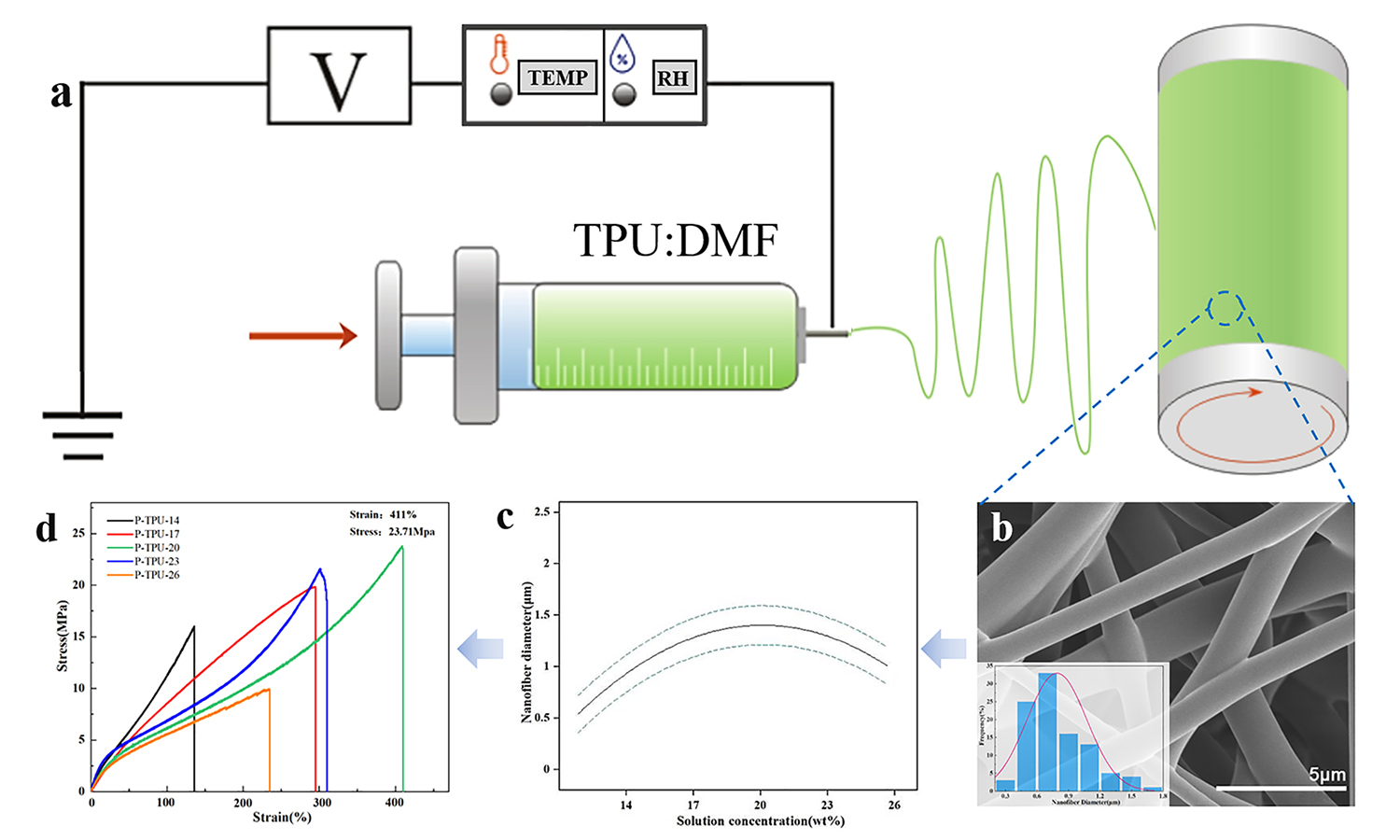
ABSTRACT
Thermoplastic polyurethanes (TPU) have attracted increasing attention due to their excellent flexibility, chemical stability, processability and greenness. The traditional processes generally limit them to civil and industrial applications, but electrospun TPU nanofibers with high porosity, high specific surface area and superior mechanical properties are promising in emerging fields. TPU nanofibers’ properties are affected by various electrospinning parameters, such as solution concentration, applied voltage, flow rate and rotational speed. Thus, 29 sets of experiments were designed here by the efficient and low-cost response surface methodology (RSM). The analysis of variance (ANOVA) revealed that the model agrees well with experimental results, and solution concentration is the most crucial parameter affecting nanofibers’ morphology and diameter. Based on it, the impacts of solution concentration and orientation on the mechanical properties of the TPU nanofiber membrane were investigated. Benefiting from the stress transfer and network deformation, the TPU nanofiber membranes parallel to the collection direction possessed the highest stress strength (23.71 MPa), while the nanofiber membranes vertical showed the widest strain range (485%). This study provides useful guidance for the preparation of high-performance TPU nanofibers, contributing to expanding its applicability in emerging fields such as biomedical, filtration and separation, and flexible sensing.
RELATED ARTICLES
Jiadong Hu, Huiling Chen, Junpeng Zhong, Changming Li, Ronggui Li, Rong Zhou, Hongwei He
Vol. 19., No.4., Pages 351-360, 2025
DOI: 10.3144/expresspolymlett.2025.26
Vol. 19., No.4., Pages 351-360, 2025
DOI: 10.3144/expresspolymlett.2025.26
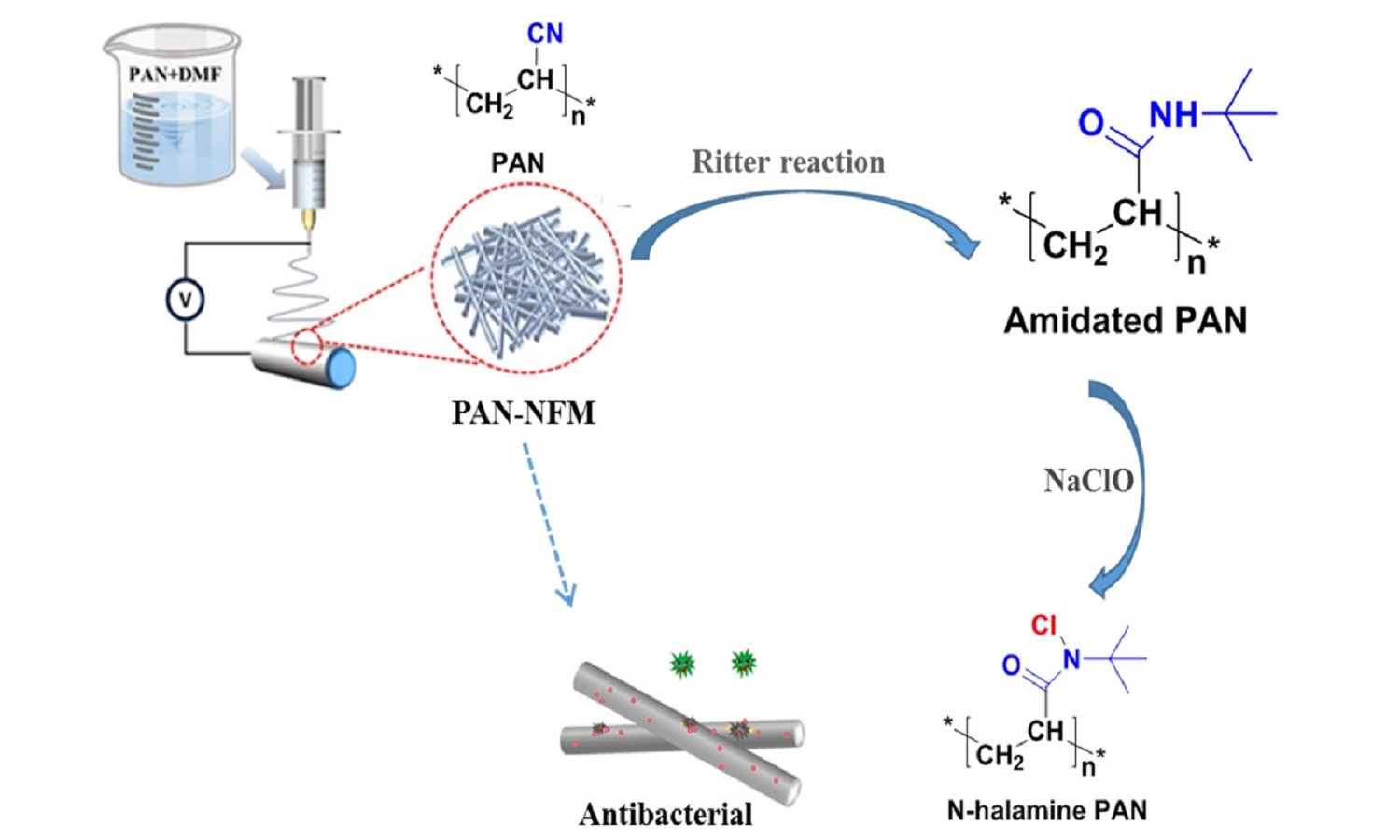
Electrospun (e-spun) nanofiber materials have emerged as a prominent research focus owing to their extensive and promising potential applications across biomedical, energy, and environmental domains. Polyacrylonitrile (PAN) is a commonly used polymer for electrospinning (e-spinning). Due to insufficient hydrophilic properties of nitrile groups of PAN, its e-spun nonwoven membranes had low water absorption and moisture absorption, which limited application in medical and health fields. In this study, it was investigated that the hydrophilic modification of e-spun PAN nanofiber membrane (NFM) was conducted via Ritter reaction to convert nitrile groups into hydrophilic amide ones, thereby improving the hydrophilicity of PAN NFMs. The surface morphologies and structure of the modified e-spun fibers were characterized and verified by SEM, FTIR and XPS. After 60–90 min of Ritter reaction, the fiber diameter of the PAN NFM became thicker, transforming from a hydrophobic membrane to a hydrophilic one, and the water contact angle decreased from 124.2 to 40.7°. The amidated PAN obtained membrane was post-treatment with sodium hypochlorite to make some amide groups change to N-halamine, which took the PAN NFM antibacterial activity or bacteriostasis. This work suggested a strategy that the espun PAN NFMs modified would have a promising application in medical dressings, air filtration, etc.
Milanta Tom, Sabu Thomas, Bastien Seantier, Yves Grohens, Mohamed Pulikaparambil Kochaidrew, Ramakrishnan Subramanian, Tapas Ranjan Mohanty, Henri Vahabi, Hanna Joseph Maria, Jibin Keloth Paduvilan, Martin George Thomas
Vol. 18., No.6., Pages 638-655, 2024
DOI: 10.3144/expresspolymlett.2024.47
Vol. 18., No.6., Pages 638-655, 2024
DOI: 10.3144/expresspolymlett.2024.47
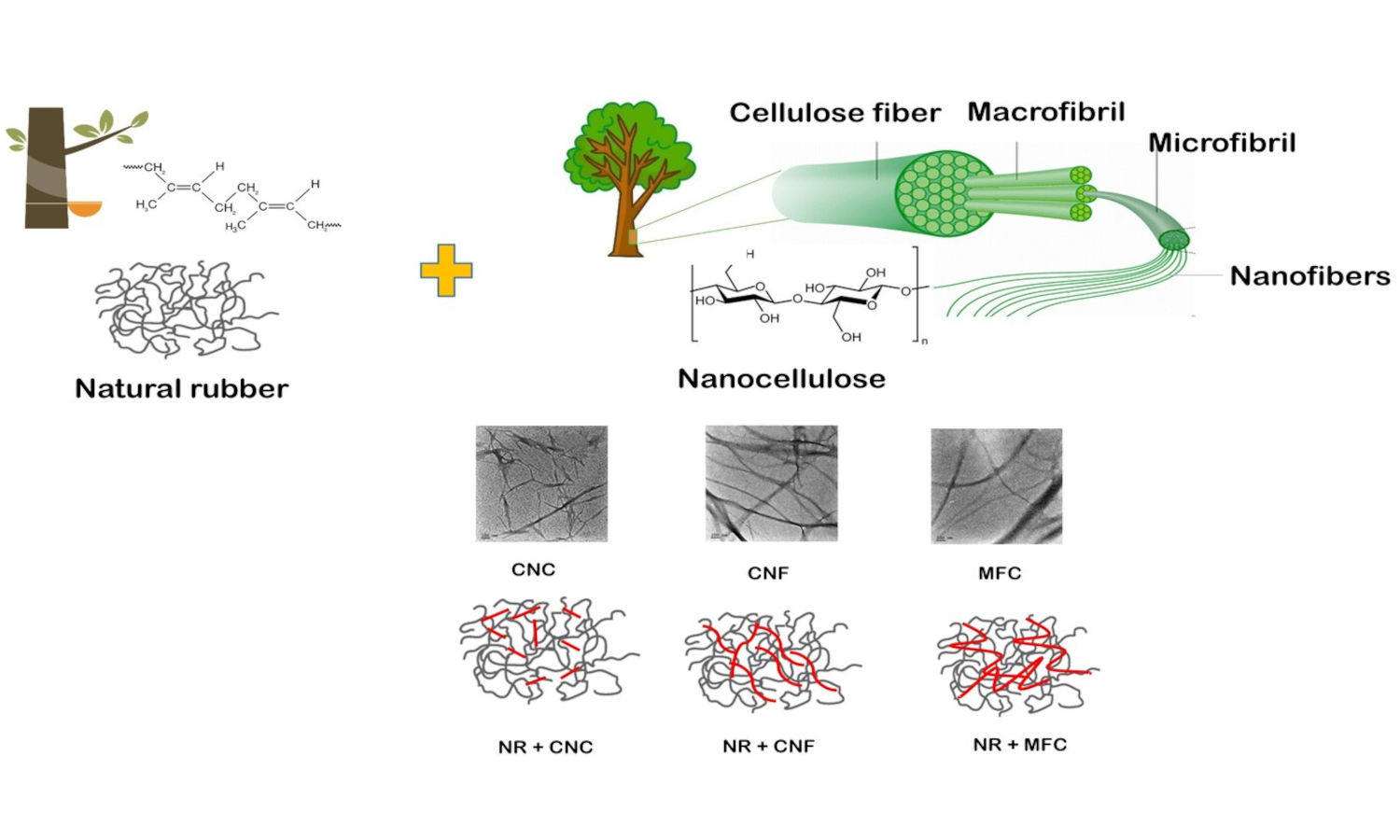
The augmented demand for
sustainable nanocomposites has paved the way to explore naturally derived
materials. Nanocellulose, with its bountiful sources and inherent properties,
ranks top in the list of biofillers with a perspective of reducing the carbon
footprint. A systematic study is required to understand the reinforcing effect
of various types of nanocellulose. In the present work, we selected three types
of nanocellulose, i.e.,
cellulose nanocrystal (CNC), cellulose nanofiber (CNF) and microfibrillated
cellulose (MFC), to investigate the effect of geometrical structure on the
properties of unvulcanized natural rubber (NR). Incorporating these fillers
improved the tensile strength and modulus of natural rubber films significantly
through reinforcement via filler network structure. The reinforcing effect of
CNF was found to be higher compared to CNC and MFC, where an increase of 3.85
MPa in tensile strength from the neat sample was obtained. More uniform
dispersion was evident through transmission electron microscopy, atomic force
microscopy and Raman imaging for CNF in the rubber matrix. The structural
properties were determined using Raman spectra and X-ray diffraction. The rheological
studies revealed a good interaction between filler and NR. The work presented
comprehensively compares different types of nanocellulose as reinforcing filler
in NR matrix, which will help the researchers select an ideal type for their
specific application and, thus, the proper usage of renewable resources,
leading to sustainability and a circular economy.
Andrea Kohári, Tamás Bárány
Vol. 18., No.5., Pages 459-460, 2024
DOI: 10.3144/expresspolymlett.2024.33
Vol. 18., No.5., Pages 459-460, 2024
DOI: 10.3144/expresspolymlett.2024.33
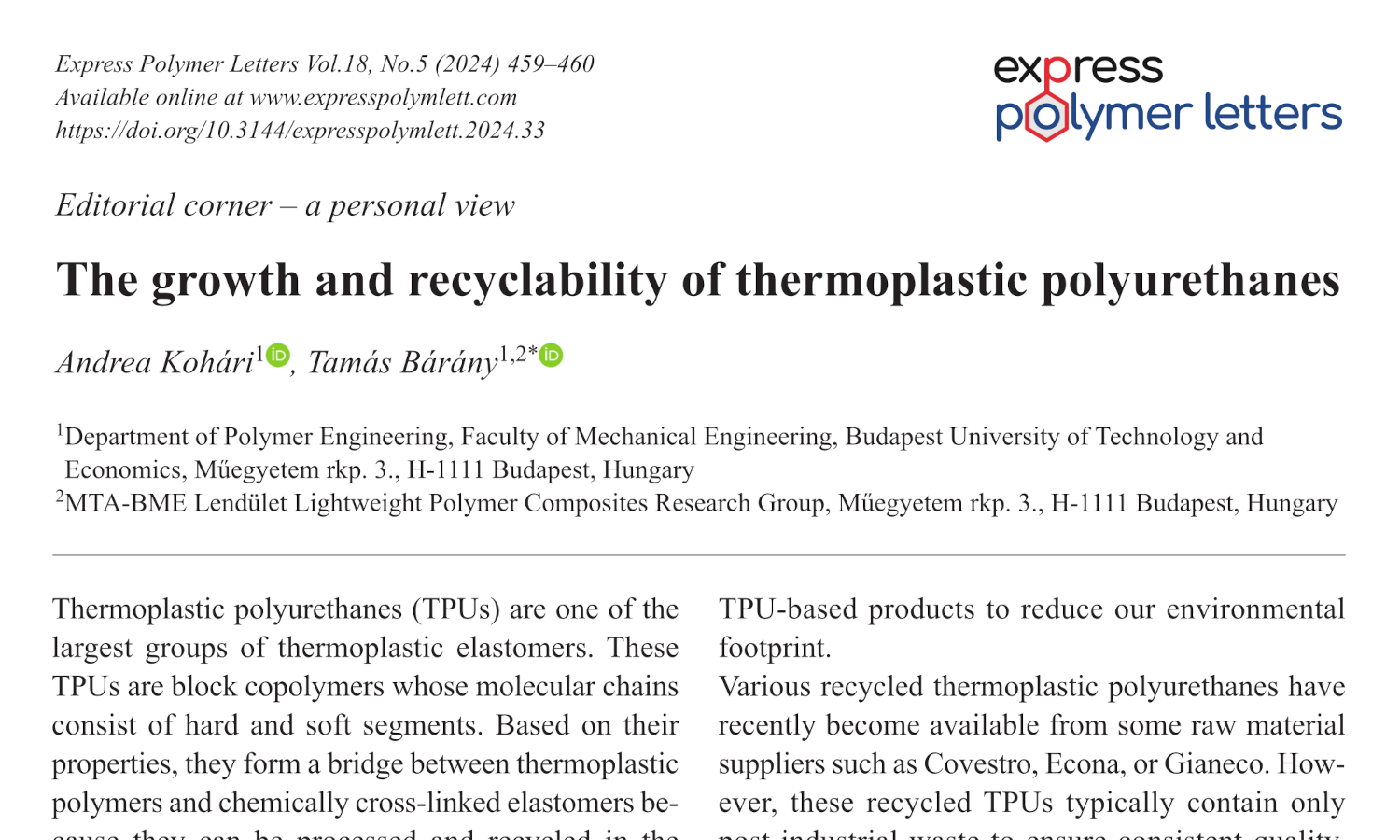
This is an editorial article. It has no abstract.
Azizon Kaesaman, Rawviyanee Romin, Charoen Nakason
Vol. 17., No.10., Pages 1056-1069, 2023
DOI: 10.3144/expresspolymlett.2023.79
Vol. 17., No.10., Pages 1056-1069, 2023
DOI: 10.3144/expresspolymlett.2023.79
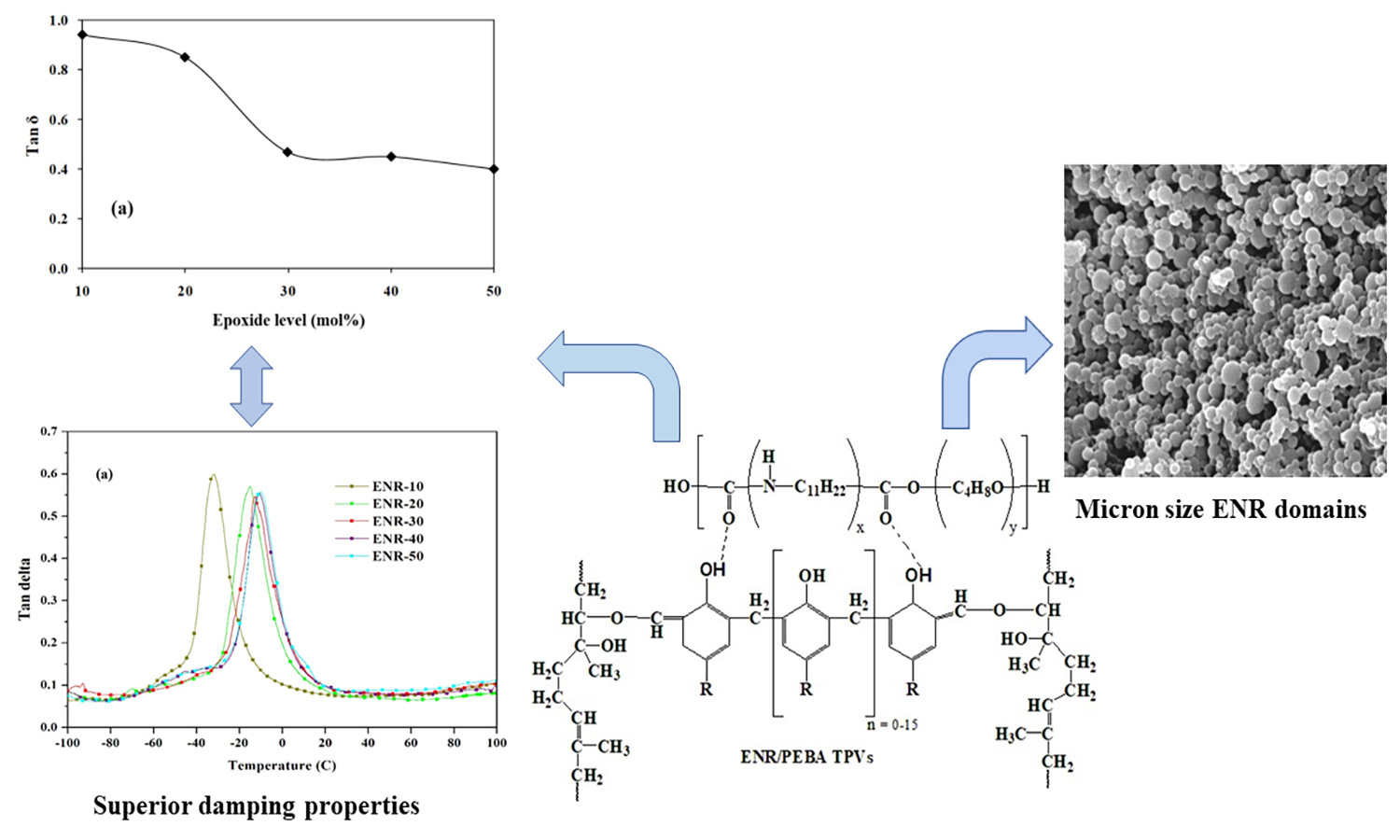
Epoxidized natural rubber (ENR) with varying levels of epoxide groups ranging from 10 to 50 mol% was prepared and dynamically phenolic vulcanized by blending it with poly(ether-block-amide) copolymer (PEBA). The results indicate that the thermoplastic vulcanizates (TPVs) of ENR/PEBA blends display a sea-island morphology and enhance a number of properties. Specifically, increasing the epoxide content and PEBA proportion enhances strength properties, including higher Young’s modulus (stiffness), toughness, tensile properties, and hardness, along with smaller vulcanized ENR domains dispersed in the PEBA matrix. Moreover, the decrease in tension set values indicates an improvement in the elastic properties. The attributed cause of this is the interaction between the polar groups present in the phenolic-cured ENR domains and the PEBA molecules. As a result, interfacial adhesion between the ENR domains and PEBA interfaces improved, contributing to the observed enhancements in the strength and elastic properties of the TPVs with smaller ENR domains. Furthermore, an increase in the epoxide content was found to be correlated with a decrease in tanδ and tension set, which further supported the observed improvements in strength and elasticity. Additionally, the ENR/PEBA blends showed a single glass transition temperature (Tg), while pure PEBA exhibited two Tgs. The presence of a single Tg in the ENR/PEBA blend is attributed to the overlapping of the Tg of the ENR and PEBA immiscible blend components.




